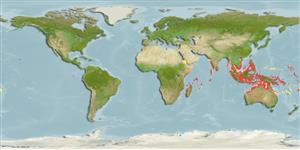>
Ovalentaria/misc (Various families in series Ovalentaria) >
Ambassidae (Asiatic glassfishes)
Etymology: Ambassis: Derived from Greek, anabasis = climbing up (Ref. 45335).
More on author: Bleeker.
Environment: milieu / climate zone / depth range / distribution range
Ökologie
seewasser; süßwasser; brackwasser demersal; amphidrom (Ref. 59012). Tropical; 19°N - 23°S
Asia: Indo-Australian Archipelago, including Indonesia, the Philippines, Borneo, Java, New Guinea, Vanuatu, New Caledonia, to northern Australia and the Andaman Sea. Reported from Palau (Ref. 6371) and the Ryukyu Islands (Ref. 559).
Length at first maturity / Size / Gewicht / Alter
Maturity: Lm 7.0 range ? - ? cm
Max length : 12.0 cm TL Männchen/unbestimmt; (Ref. 7050); common length : 5.0 cm SL Männchen/unbestimmt; (Ref. 7242); max. veröff. Gewicht: 12.00 g (Ref. 7242)
Rückenflossenstacheln (insgesamt): 8; Rückenflossenweichstrahlen (insgesamt): 9-10; Afterflossenstacheln 3; Afterflossenweichstrahlen: 9 - 10. Body very high, 50% of SL. Lateral line incomplete, but a few pored scales on a silvery midlateral band. Lower margin of inter operculum with few spines. The second spine of the first dorsal fin is strong and very long.
Found in brackish-water, mangrove, estuarine and freshwater-stream habitats, usually within 20 km of the sea (Ref. 2847). They occur at temperatures ranging from 28 to 32°C. Found in schools and migrate to freshwater. Mainly diurnal. A predominantly marine or estuarine spawner. Caught by hand and scoop nets (Ref. 7242).
A nonobligatory plant spawner.
Allen, G.R., 1991. Field guide to the freshwater fishes of New Guinea. Publication, no. 9. 268 p. Christensen Research Institute, Madang, Papua New Guinea. (Ref. 2847)
IUCN Rote Liste Status (Ref. 130435)
Bedrohung für Menschen
Harmless
Nutzung durch Menschen
Fischereien: weniger kommerziell
Mehr Information
ReferenzenAquakulturAquakultur ProfilZuchtlinienGenetikElectrophoresesVererbbarkeitKrankheitenVerarbeitungNutrientsMass conversion
PartnerBilderStamps, Coins Misc.LauteCiguateraGeschwindigkeitSchwimmstilKiemenoberflächeOtolithsGehirngrößeSehfähigkeit
Tools
Zusatzinformationen
Download XML
Internet Quellen
Estimates based on models
Preferred temperature (Ref.
123201): 26.7 - 29.1, mean 28.4 °C (based on 1018 cells).
Phylogenetic diversity index (Ref.
82804): PD
50 = 0.5000 [Uniqueness, from 0.5 = low to 2.0 = high].
Bayesian length-weight: a=0.01175 (0.00677 - 0.02038), b=2.96 (2.81 - 3.11), in cm total length, based on LWR estimates for this species & Genus-body shape (Ref.
93245).
Trophic level (Ref.
69278): 2.7 ±0.1 se; based on diet studies.
Widerstandsfähigkeit (Ref.
120179): hoch, Verdopplung der Population dauert weniger als 15 Monate. (Fec=29,000-310,000).
Fishing Vulnerability (Ref.
59153): Low vulnerability (10 of 100).
